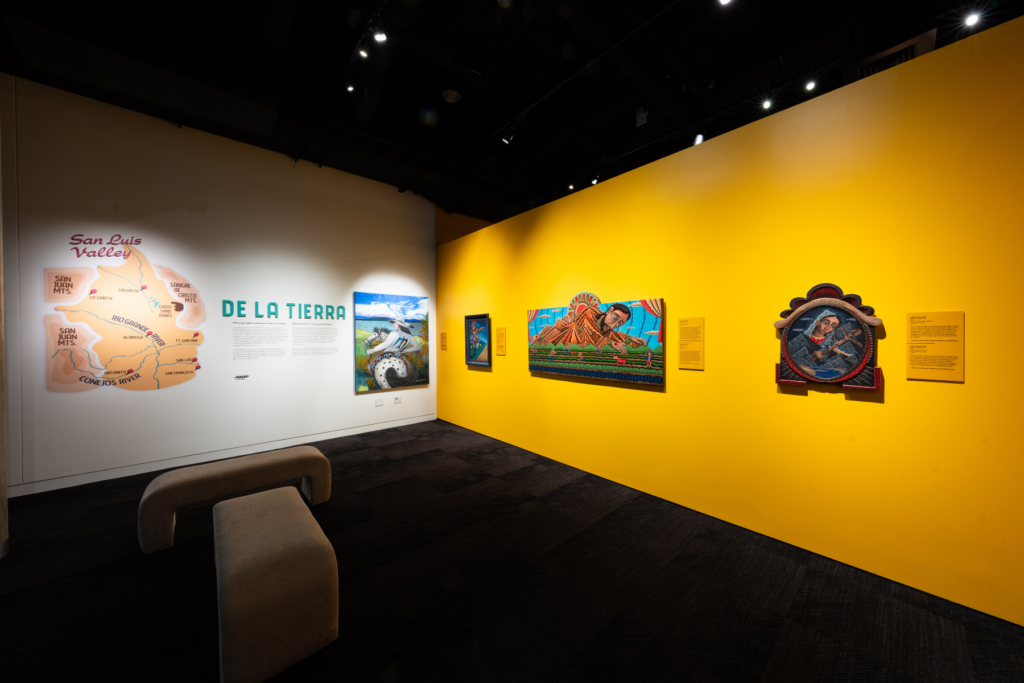In an innovative shift, History Colorado is transforming how visitors experience the past by integrating work from living artists throughout its exhibitions. A Black mother paints her toddler son, worried about his future. A New Mexican artist’s religious-inspired work hangs next to century-old pieces. These contemporary voices are helping reshape how we understand our shared history.
There are moments in our history where the words can’t reach and that is why we need the arts sometimes to tell those aspects of our history,” said Dawn DiPrince, president and CEO of History Colorado.
This approach spans all 11 of the museum system’s facilities and historic sites across Colorado. Rather than treating art as mere decoration, History Colorado incorporates it as an essential storytelling tool, particularly when addressing challenging subjects.
Artist Aisha Renee’s mural “Save Some Democracy For Me,” now part of the museum’s permanent collection and on view in the ‘Viva la Causa” exhibition, exemplifies this strategy. Created during the social upheaval of 2020, the piece features her young son and his friend against a black-and-white American flag, with golden halos and celestial elements adorning the children. The monochromatic flag represents what Renee calls “our America,” while the gold metallic medium dripping from above symbolizes an inherent light that “covers the surface regardless of how you feel about them.”
Courtesy Aisha Renee
“Right now they’re just cute little kids,” Renee said. “But in the future, they’ll be Black men. And that might give people cause to not want them around or fear them or just objectify them.”
“During that time, I was a new mother. My son was very young. The world was, it had gone mad. I liken it to Gotham City,” she continued. “We had COVID, had protests against racism. We had just complete pandemonium.”
Brandon Maldonado’s work draws deeply from New Mexican and Southern Colorado Hispanic imagery, particularly the Santo tradition of religious art dating back to the 1800s. His pieces include “Sangre de Cristo,” depicting Christ as a mountain range with field workers and water ditches below, and a contemporary interpretation of Doña Sebastiana, a skeletal folk saint figure historically used in Penitente Brotherhood processions.
“To see my death cart, my Dona Sebastiano piece, side by side with one that’s at least a hundred years old is breathtaking and is a special moment for me,” Maldonado said. His work creates a direct dialogue between past and present, connecting contemporary artistic practice with centuries-old traditions.

Courtesy Trevor Gass/History Colorado
The museum’s process for selecting artists emphasizes community connections and regional representation. Lucha Martinez de Luna, associate curator of Latino, Hispano and Chicano History and Culture, explained that looking beyond Denver’s art scene is crucial.
This is particularly illustrated in the De la Tierra: Reflections of Place in the Upper Río Grande and Borderlands exhibitions.
“It was very important to find two contemporary artists from Northern New Mexico and also from Southern Colorado,” Martinez de Luna said. “We tend to very much focus on Denver, but this exhibit was an opportunity for me to invite very important artists that have spent a lifetime in Southern Colorado and northern New Mexico that aren’t often as recognized here in Denver.”
Financial constraints remain a challenge. While the museum provides honorariums, most contemporary pieces are displayed on loan rather than acquired for the permanent collection. Martinez de Luna hopes to secure funding to purchase more works from living artists in the future.
For artist Brandon Maldonado, whose work is displayed alongside historical religious artifacts, the experience connects deeply with his heritage. When you do your ancestry and looking on my family tree, I’m seeing, wow, these people are living. I have ancestors living in those towns that these were created in that time period. And it’s like, wow, this was a part of my family story. And it becomes meaningful,” he said.

Courtesy History Colorado
This integration of contemporary art is also helping rebuild trust with communities historically excluded from museum spaces. The museum’s approach has shifted from interpretation to amplification of community voices.
“Old school type of museums where we come into a community and we interpret these communities. We just do not do that anymore,” Martinez de Luna explained. “These new collections are the voices of our community. It’s not the voice of History Colorado. It’s the voice of our community.”
While some visitors initially question finding contemporary art in a history museum, DiPrince said they quickly understand its impact. The museum’s leadership sees this evolution as essential to its mission of making history accessible and relevant to all Coloradans.
For the artists, inclusion in these exhibitions carries profound meaning. “It was surreal. It was a magical moment for me, just knowing that here I am, just as small as I am in this world, and my voice is being added to a history museum,” Renee said.
As History Colorado continues this transformation, both artists and museum leadership see art as a bridge between past and present, making historical narratives more accessible and emotionally resonant for visitors.
“The arts really does bring these stories together and connect us as humans,” DiPrince said, “and we’re on a journey to continue to bring in and connect and build the network of people who love and support and understand the power of history.”

